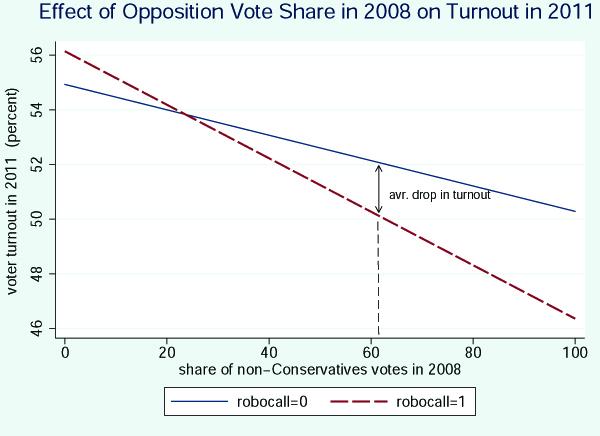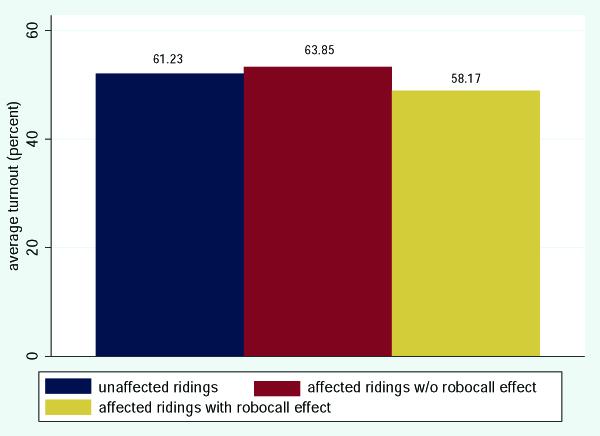Misinformation and elections: Insights from Canada
Does misinformation demobilise the electorate? Measuring the impact of alleged ‘robocalls’ on voter turnout in the 2011 Canadian federal election.
Search the site
Does misinformation demobilise the electorate? Measuring the impact of alleged ‘robocalls’ on voter turnout in the 2011 Canadian federal election.
The 2011 Canadian Federal Election saw the Conservative Party form a majority government for the first time in 18 years. But the margin of majority was relatively narrow (seven seats) and the election was soon followed by allegations of improper campaigning. Most of these allegations relate to complaints made by electors that they had been contacted by telephone in the days before the election with false information that their polling station had changed (voters must vote at a particular polling station in Canada). These phone calls appeared to be targeted at voters that previously had informed the Conservative party they would not support them. Because many of the phone calls were automated, this has been popularly referred to as the ‘robocall scandal’.
The breadth of the fraudulent calls has been difficult to determine. A poll conducted by Ipsos-Reid suggested 4% of Canadians strongly believed they received phone calls intended to mislead them about where to vote. At the same time, Elections Canada received only 800 formal complaints by voters about personally receiving such a call. Moreover, neither survey reports nor complaints provide much information on the actual impact – whether and to what extent the alleged demobilisation efforts actually deterred voters from going to the polls. And due to practical and ethical limitations, there has been very little previous research on the impact of deliberate misinformation on voter turnout.
Our contribution is to estimate the effect of the alleged robocalls on voter turnout in the most recent Canadian Federal Election. In doing so, we must overcome two limitations of the data.
The first limitation is that since we have no data on which voters were targeted, we have to rely on media reports of robocalls. While a final report on factual calls may become available as a result of Elections Canada investigations, it does not currently exist. Instead, we assign the indicator ‘robocalled’ to the 27 electoral districts (ridings) that were part of the first wave of allegations; and appeared on a list of ridings under investigation by Elections Canada that was reported to have been leaked by one of their employees. Subsequent reports may well have been influenced by these early reports, and therefore are likely to be even less reliable.
The second, and more important challenge when estimating the impact of possible misinformation on voter turnout is that the districts that were subject to the phone calls are unlikely to constitute a random sample. In particular, one plausible selection criterion for anyone who deliberately sought to suppress the vote is the expected margin of victory, i.e., those districts where the race was expected to be close (and thus the impact of any calls likely largest) could have been deliberately targeted.
The data support this presumption: the average winning margin for districts with no robocall allegations was 10,903 votes or 22.8 percentage points. Ridings where allegations of impropriety have emerged, in contrast, had a margin of victory that was almost 28% lower: 8,719 votes or 16.3 percentage points.
Identifying a causal effect of demobilisation efforts on turnout
For this reason, we employ a slightly different strategy: instead of using between-district variation to identify the effect of alleged misconduct, we use within district variation at the level of the polling station. This allows us to control for district-level effects such changes in candidate quality, district level time trends, local TV ad buys, etc. On average, an electoral district has roughly 250 polling stations, which display a considerable within-district variation in turnout and voting patterns: while some polling stations voted predominantly Conservative, others leaned mostly towards opposition parties. Moreover, the latter experienced a drop in voter turnout from the 2008 to the 2011 election, whereas turnout at the former rose between the 2008 and the 2011 election, relative to the district average. Our identifying strategy is then the following: Assume the instigator of the robocalls randomly called all non-Conservative voters in the 27 treated electoral districts. If the calls had the intended effect, then polls with a higher-fraction of non-Conservative voters should experience a larger drop in turnout than comparable stations in non-robocalled districts. Expressed differently, the difference between how Conservative voters and non-Conservative voters turned out at the polls should be more pronounced in those ridings that were allegedly targeted by calls directed to suppress the (presumably non-Conservative) vote, controlling for poll level turnout in the previous election.
Main findingsOur results suggest that opposition voters were in fact discouraged from going to the polls. In a representative polling station with a nation-wide average share of 62% non-Conservative voters, we estimate a differential effect on turnout of – 3%; this estimate is significant at the 1% confidence level. That is, our point estimate indicates that robocalls reduced turnout of opposition voters by an average of 3% in the affected districts, or 2,700 votes. Figure 1 illustrates the finding.
Figure 1. Effect of opposition vote share in 2008 on turnout in 2011

We have to urge caution in interpreting these results. First, it must be emphasised that our findings relate to the estimated average effect of reported robocalls. Hence, they cannot bear on the question of how actual fraudulent calls affected the election results in any particular district. However, we are able to establish that where robocalls occurred, they were likely effective in suppressing turnout of non-Conservative voters. Second, while the results continue to hold if we control for measures of campaign intensity like Conservative spending, we cannot rule out that the incidence of robocalls is correlated with unobservable campaign intensity. With these caveats, the measured impact of robocalls is shown in Figure 2 below.
Figure 2. The robocall effect

While our research suggests that the technology that was used to conduct these calls is extremely effective on a dollars-per-vote basis, it seems unlikely that the same calls would be equally effective in subsequent elections, as the broad coverage this story has received in the Canadian media will likely serve to make voters very sceptical of similar messages in the future. In fact, the only research that has been done on this topic suggests that warning voters of misleading information completely undoes its effect (Barton 2011).1
ReferencesBarton, J (2011), “Keeping Out the Vote: An Experiment on Voter Demobilization”, mimeo, Interdisciplinary Center for Economic Science, George Mason University.
1 Of course, the news coverage of the robocall scandal in Canada may not inoculate voters in other countries from the effects of misinformation.
315 Reads